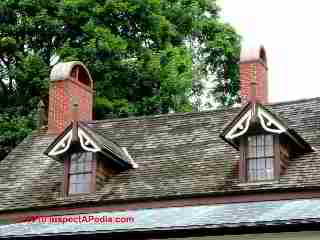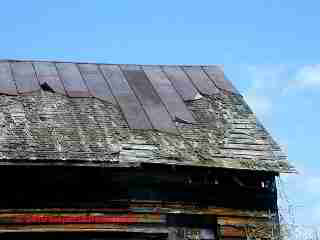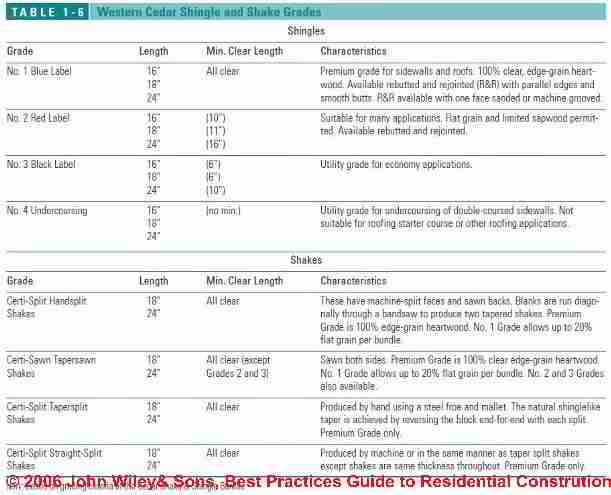 Wood Roof Shingles & Shake Properties
Wood Roof Shingles & Shake Properties
- POST a QUESTION or COMMENT about wood shakes & shingles
Wood roof shakes & shingles, properties:
This article discusses the properties of wood roof shingles and shakes, including shingle grades, wood species used in roofing, and wood roof shingle or shake warranties. Our page top photo shows a wood shingle roof on the historic Mesier Homestead in Wappingers Falls, NY.
InspectAPedia tolerates no conflicts of interest. We have no relationship with advertisers, products, or services discussed at this website.
- Daniel Friedman, Publisher/Editor/Author - See WHO ARE WE?
Wood Roof Shingles & Shakes: Materials, Grades, Properties, Warranties
 Adapted/paraphrased with permission from Best Practices Guide to Residential Construction (Steve Bliss, J Wiley & Sons) , chapter on BEST ROOFING PRACTICES:
Adapted/paraphrased with permission from Best Practices Guide to Residential Construction (Steve Bliss, J Wiley & Sons) , chapter on BEST ROOFING PRACTICES:
[Click to enlarge any image]
Wood shakes and shingles are traditional American roof coverings dating back to Colonial times. They remain popular in many coastal areas and are common or even mandated in certain historic districts.
Traditionally, wood roofs were laid on spaced sheathing, which provided good ventilation around the shingles and contributed to a service life of 30 years or more.
New wood roofs set on solid sheathing have been known to fail in 10 years or less unless the installer takes adequate precautions to allow for good drainage and drying of the wood roofing materials.
With installed costs of over $600 per square for premium materials, it is important to design a roof that will last.
Materials Used in Wood Shingle & Shake Roofs
Wood shakes and shingles soak up water through their end grain, dry unevenly in the sun, and slowly erode on the surface from a combination of ultraviolet radiation, wind, and precipitation. In humid conditions, wood shingles may become a breeding ground for moss, lichen, and decay fungi. To survive those harsh conditions, wood roofing should be made from a durable wood species that is either naturally decay-resistant or pressure-treated.
Wood Species for Wood Shingle or Shake Roofs
The most commonly used wood on roofs today is western red cedar. The heartwood of red cedar is rich in extractives that provide natural decay resistance. Eastern white cedar also has good decay resistance and is commonly used on the East Coast.
However, white cedar is typically flat-sawn and has a mix of heartwood and sapwood, making it less durable on a roof and more prone to cupping and splitting. Other less common species with good track records are Northern white cedar, Alaskan yellow cedar (actually a cypress), and white oak.
Whatever species is selected, use the best grade available. With red cedar and other decay-resistant species, the heartwood is far more decay-resistant than the sapwood. Edge-grain wood is more stable and less prone to cupping and splitting than less expensive flat-grain wood. The best choice for wood roofing is all-heart, edge-grained shakes or shingles.
Wood Shingle & Shake Shingle Grade Choices
Make sure the lumber to be purchased has been graded under the authority of a recognized grading agency such as the Cedar Shake and Shingle Bureau for red cedar or the Southern Pine Inspection Bureau for yellow pine. A blue label on the packaging, for example, may simply be a marketing tactic and does not necessary indicate that the shakes or shingles are certified as Grade 1.
Wood Shingle & Shake Roof Warranties
If installed in accordance with the Cedar Shake and Shingle Bureau’s specifications by a certified installer, the CSSB will guarantee wood roofing for 20 to 25 years, depending on the thickness of the shake or shingle. Some pressure-treated shakes and shingles carry warranties of up to 50 years.
Preservative Treatment for Wood Shingle or Shake Roofs
If premium red or white cedar is too expensive, consider pressure-treated southern yellow pine shakes and shingles. In its favor, yellow pine is a tougher and stronger wood, and although not as pretty as red cedar when new, over time they will both weather to a similar silver gray.
Because penetration of the treatment is nearly 100%, pressure-treated pine shingles carry guarantees against decay for up to 50 years, making them well suited to high-moisture environments, shallow slopes, and shady wooded sites where organic matter may collect on the roof. The preservatives should not leach out over time.
One drawback to yellow pine shingles and shakes is that many are flat-grained, so most come pretreated with a water repellent to help them resist cupping and splitting. However, retreatment with a water repellent at some point may be required for optimal performance.
Western red cedar shingles are also available pressure-treated for severe applications where standard cedar shingles are prone to decay.
More about preservatives and treatments for wood shingles and shakes is detailed at WOOD ROOF COATINGS & FIRE RATINGS and at WOOD ROOF MAINTENANCE.
Characteristics & Grades of Wood Roof Shingles
Shingles are sawn from blocks of wood, which gives them two smooth faces. They are relatively thin and cut to a taper. Red cedar shingles come in four grades, but most roofs use No. 1 or No. 2, which are all edge-grain heartwood (Table 1-6 below). They are available rebutted and rejointed (R&R), where a uniform appearance is desired, or machine-grooved for a textured surface.
[Click any image or table for a larger, more detailed version.]

Eastern white cedar shingles are also available in four grades. Most roofing work uses Grade A (Extra), which is all-clear, all-heartwood, or Grade B (Clear), which has no knots on the exposed face (see Table 1-7 shown below).

Characteristics & Grades of Wood Roof Shakes
Shakes are split from large blocks of wood and may be resawn to create a taper.
They are heavier than shingles, less uniform in thickness, and are generally rough-textured on one or both sides creating a more rustic appearance. Grades and characteristics for red cedar shakes and shingles are found in Table 1-6 shown earlier. Red cedar shakes come either tapered or untapered and are usually installed on roofs in Premium or No. 1 grade.
Fire-Retardant Treatment for Wood Shingle Roofs
Once popular on the West Coast, wood roofs have been banned in many residential areas by fire regulations designed to slow the spread of wildfires.
Fire-retardant treated (FRT) shingles and shakes have been developed to address these issues and can obtain a Class B or C rating when combined with other components in a fire-resistant roof system. With pretreated shingles, consult with the treating company regarding fastener requirements and any special application instructions.
- - Adapted with permission from Best Practices Guide to Residential Construction (Steve Bliss, J Wiley & Sons) .
Resources: Roofing Materials & Equipment Suppliers
Manufacturers
Ridge Vents
Air Vent/A Gibraltar Company www.airvent.com A complete line of roof ventilation products, including shingle-over and exposed-ridge vents with exterior wind baffles and internal weather filters. Also soffit and drip edge vents and passive and powered attic turbine-type vents.
Benjamin Obdyke www.benjaminobdyke.com Shingle-over ridge vents. Low-profile Roll Vent uses nylonmatrix. Extractor vent is molded polypropylene with internal and external baffles.
Cor-A-Vent www.cor-a-vent.com Shingle-over low-profile ridge vents, including Cor-a-vent, Fold-a-vent, and X-5 ridge vent, designed for extreme weather. Corrugated core.
GAF Materials Corp. www.gaf.com Cobra vent: roll-out shingle-over ridge vent with a polyester-matrix core 102 CHAPTER 2 | Roofing
Mid-America Building Products www.midamericabuilding.com Ridge Master and Hip Master shingle-over molded plastic ridge vents with internal baffles and foam filter
Owens Corning www.owenscorning.com VentSure corrugated polypropylene ridge vents; also passive roof vents and soffit vents
Trimline Building Products www.trimline-products.com Shingle-over low-profile ridge vents, Flow-Thru battens for tile roofs
Elk Premium Building Products www.elkcorp.com Highpoint polypropylene shingle-over ridge vents
Tamko Roofing Products www.tamko.com Shingle-over ridge matrix–type Roll Vent and Rapid Ridge (nail gun version) and Coolridge, which is molded polypropylene with external and internal baffles
Venting Underlayments
Benjamin Obdyke www.benjaminobdyke.com Cedar Breather, a 3/8 -in.-thick matrix-type underlayment designed to provide ventilation and drainage space under wood roofing
More Information about Roofing Materials, Methods, Standards
Asphalt Roofing Manufacturers Association (ARMA) www.asphaltroofing.org
Cedar Shake and Shingle Bureau www.cedarbureau.org
Metal Roofing Alliance www.metalroofing.com
Tile Roofing Institute www.tileroofing.org
#######
- - Adapted with permission from Best Practices Guide to Residential Construction (Steve Bliss, J Wiley & Sons) .
This article series discusses best practices in the selection and installation of residential roofing. This article includes excerpts or adaptations from Best Practices Guide to Residential Construction (Steve Bliss, J Wiley & Sons) , by Steven Bliss, courtesy of Wiley & Sons
...
Continue reading at WOOD SHINGLES, RE-ROOFING WITH or select a topic from the closely-related articles below, or see the complete ARTICLE INDEX.
Or see these
Recommended Articles
Suggested citation for this web page
WOOD ROOF SHINGLE PROPERTIES at InspectApedia.com - online encyclopedia of building & environmental inspection, testing, diagnosis, repair, & problem prevention advice.
Or see this
INDEX to RELATED ARTICLES: ARTICLE INDEX to BUILDING ROOFING
Or use the SEARCH BOX found below to Ask a Question or Search InspectApedia
Ask a Question or Search InspectApedia
Try the search box just below, or if you prefer, post a question or comment in the Comments box below and we will respond promptly.
Search the InspectApedia website
Note: appearance of your Comment below may be delayed: if your comment contains an image, photograph, web link, or text that looks to the software as if it might be a web link, your posting will appear after it has been approved by a moderator. Apologies for the delay.
Only one image can be added per comment but you can post as many comments, and therefore images, as you like.
You will not receive a notification when a response to your question has been posted.
Please bookmark this page to make it easy for you to check back for our response.
IF above you see "Comment Form is loading comments..." then COMMENT BOX - countable.ca / bawkbox.com IS NOT WORKING.
In any case you are welcome to send an email directly to us at InspectApedia.com at editor@inspectApedia.com
We'll reply to you directly. Please help us help you by noting, in your email, the URL of the InspectApedia page where you wanted to comment.
Citations & References
In addition to any citations in the article above, a full list is available on request.
- ARMA - Asphalt Roofing Manufacturer's Association - Asphalt Roofing Manufacturer's Association - https://www.asphaltroofing.org/
750 National Press Building, 529 14th Street, NW, Washington, DC 20045, Tel: 202 / 207-0917 - ASTM International, 100 Barr Harbor Drive, PO Box C700, West Conshohocken, PA, 19428-2959 USA The ASTM standards listed below can be purchased in fulltext directly from http://www.astm.org/
- Cedar Shake & Shingle Bureau, CSSB, U.S.: Sumas, WA 98295-1178, Tel: 604-820-7700, In Canada: Cedar Shake and Shingle Bureau #2 - 7101 Horne Street, Mission, BC V2V 7A2 Tel: (604) 820-7700, E-mail: info@cedarbureau.com , Web: http://www.cedarbureau.org/
- U.S. Forest Products Laboratory, US FPL, One Gifford Pinchot Drive, Madison, WI 53726, Tel: (608) 231-9200, Email: mailroom_forest_products_laboratory@fs.fed.us608-231-9200, website: http://www.fpl.fs.fed.us/
- NRCA - National Roofing Contractors Association - Website: www.nrca.net 10255 W. Higgins Road, Suite 600, Rosemont, IL 60018-5607, Tel: (847) 299-9070
- UL - Underwriters Laboratories - https://www.ul.com/
2600 N.W. Lake Rd.
Camas, WA 98607-8542
Tel: 1.877.854.3577 / Fax: 1.360.817.6278 E-mail: cec.us@us.ul.com - Our recommended books about building & mechanical systems design, inspection, problem diagnosis, and repair, and about indoor environment and IAQ testing, diagnosis, and cleanup are at the InspectAPedia Bookstore. Also see our Book Reviews - InspectAPedia.
- Best Practices Guide to Residential Construction, by Steven Bliss. John Wiley & Sons, 2006. ISBN-10: 0471648361, ISBN-13: 978-0471648369, Hardcover: 320 pages, available from Amazon.com and also Wiley.com. See our book review of this publication.
- Decks and Porches, the JLC Guide to, Best Practices for Outdoor Spaces, Steve Bliss (Editor), The Journal of Light Construction, Williston VT, 2010 ISBN 10: 1-928580-42-4, ISBN 13: 978-1-928580-42-3, available from Amazon.com
- The Journal of Light Construction has generously given reprint permission to InspectAPedia.com for this article. All rights and contents are ©Journal of Light Construction and may not be reproduced in any form.
- Roof failure causes in depth (and specific methods for avoiding them)
- Roof design fundamentals and flourishes, based on voluminous industry research and experience
- Wood Shingle Roofs, Care and Maintenance of wood shingle and shake roofs, (EC), Stanley S. Niemiec (out of print)
- In addition to citations & references found in this article, see the research citations given at the end of the related articles found at our suggested
CONTINUE READING or RECOMMENDED ARTICLES.
- Carson, Dunlop & Associates Ltd., 120 Carlton Street Suite 407, Toronto ON M5A 4K2. Tel: (416) 964-9415 1-800-268-7070 Email: info@carsondunlop.com. Alan Carson is a past president of ASHI, the American Society of Home Inspectors.
Thanks to Alan Carson and Bob Dunlop, for permission for InspectAPedia to use text excerpts from The HOME REFERENCE BOOK - the Encyclopedia of Homes and to use illustrations from The ILLUSTRATED HOME .
Carson Dunlop Associates provides extensive home inspection education and report writing material. In gratitude we provide links to tsome Carson Dunlop Associates products and services.

